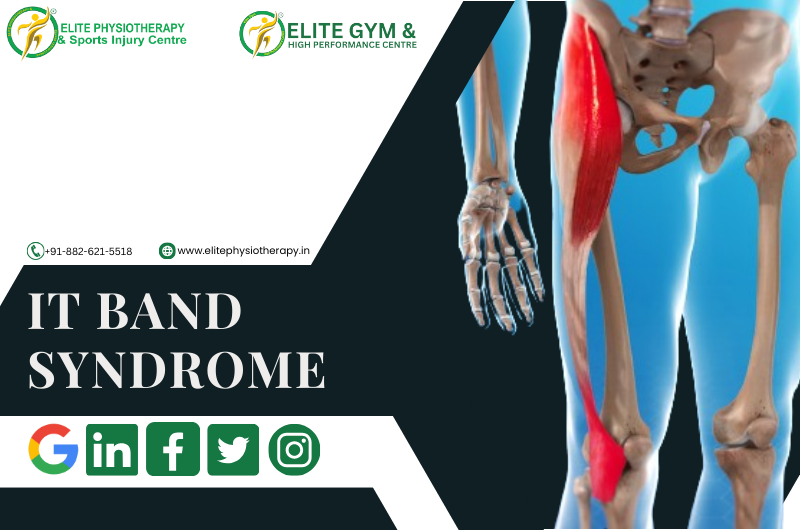Introduction
Iliotibial Band Syndrome (ITBS) is a prevalent overuse injury among athletes, particularly runners and cyclists. It commonly impairs performance and day-to-day activities by presenting as pain on the outside of the knee. Our expertise in identifying and treating ITBS at Elite Physiotherapy and Sports Injury Centre guarantees a quick and efficient return to activities.
Understanding the Iliotibial Band
The iliotibial (IT) band is a thick band of fascia extending from the hip’s lateral aspect down to the outer part of the knee. It plays a crucial role in stabilizing the knee during movement. When this band becomes tight or inflamed, it can lead to ITBS.
Causes of IT Band Syndrome
Iliotibial Band Syndrome develops as a result of several factors:
- Training Errors: The IT band may be strained by abrupt increases in training time or intensity, insufficient rest, and inadequate warm-up exercises.
- Biomechanical Problems: Poor running mechanics, excessive foot pronation, and variations in leg length can all put more strain on the IT band.
- Muscle Imbalances: Improper leg alignment can exacerbate IT band friction if there is weakness in the hip abductors, gluteal muscles, and core.
Repetitive knee flexion and extension usually result in ITBS because the IT band rubs against the lateral femoral epicondyle. Particularly when running or cycling, this friction causes irritation and inflammation.
Signs and Symptoms
Individuals with Iliotibial Band Syndrome may experience:
- Lateral Knee Pain: A searing or sharp pain on the outside of the knee that usually gets worse when you move.
- Tenderness: Sensitivity, especially close to the knee, along the IT band.
- Swelling: Localized swelling on the outside of the knee.
- Pain with Movement: Uncomfortable when doing things like climbing stairs or sitting for extended periods of time.
- Audible Sounds: During movement, the outside of the knee may snap or pop.
Diagnostic Approach at Elite Physiotherapy
At Elite Physiotherapy and Sports Injury Centre, we employ a comprehensive assessment to diagnose ITBS:
Physical Examination
- Posture and Gait Analysis: Analyzing alignment and movement patterns to spot irregularities.
- Palpation: Evaluating the IT band’s softness.
- Range of Motion Tests: Assessing ankle, knee, and hip joint mobility and flexibility.
Functional Assessment
- Activity Simulation: Keeping an eye on mechanics when cycling or jogging in order to spot problematic trends.
- Strength testing: Involves determining how strong the quadriceps, gluteal muscles, and hip abductors are.
Special Physiotherapy Tests
- Ober’s Test: Determines how tight an IT band is.
- The Noble Compression Test: Detects crepitus or pain at the lateral femoral condyle when the knee is moved.
- Modified Thomas Test: Assesses hip flexor and IT band flexibility.
Physiotherapy Management at Elite Physiotherapy
Our tailored approach focuses on alleviating symptoms, addressing underlying causes, and preventing recurrence:
Pain Management
- Cryotherapy: Using ice packs to decrease inflammation and numb pain.
- Electrotherapy: Pain management through the use of techniques such as transcutaneous electrical nerve stimulation (TENS).
Manual Therapy
- Soft Tissue Mobilization: To relieve tension, deep tissue massage is used to target the gluteal muscles, tensor fasciae latae (TFL), and IT band.
- Myofascial Release: Resolving trigger points in the IT band and surrounding muscles.
- Joint Mobilization: Improving hip, knee, and ankle joint alignment and mobility.
Stretching Activities
Improving flexibility in the IT band and surrounding muscles:
- Standing IT Band Stretch: Lean sideways and cross one leg behind the other to perform a standing IT band stretch that stretches the outer thigh.
- Seated Glute Stretch: Stretching the glutes while seated involves placing one ankle over the other knee and applying light pressure to the elevated knee.
Strengthening Exercises
Building strength to correct muscle imbalances:
- Clamshells: Bend your knees while lying on your side, then open and close your top knee in a clamshell motion.
- Lateral Band Walks: Using a resistance band over your ankles, perform lateral band walks while keeping the band taut.
- Single-Leg Deadlifts: Lower your torso while extending the other leg behind you while maintaining balance on one leg and hunching at the hips.
- Step-Ups: Focus on controlled motions as you step onto a platform with one leg and raise the other leg.
Biomechanical Correction
- Gait Retraining: Using techniques to improve walking or running patterns is known as gait retraining.
- Footwear Assessment: Making recommendations for suitable footwear or orthotics to correct foot mechanics.
Advanced Modalities
Incorporating state-of-the-art technologies to enhance recovery:
- Shock Wave Therapy: Encourages the IT band to recover by using acoustic waves.
- The Super Inductive System: uses electromagnetic fields to provide pain alleviation and deep tissue repair.
- High-Intensity Class 4 Laser Therapy: Uses concentrated light energy to speed up tissue repair and lessen inflammation.
- Hydrotherapy: Lessens joint impact while enabling movement-based recovery
- Taping: Using kinesiology taping to relieve tension and promote biomechanics
Why Choose Elite Physiotherapy for IT Band Syndrome?
We offer a holistic and science-backed approach to musculoskeletal injuries at Elite Physiotherapy and Sports Injury Center. Our combination of clinical expertise, world-class facilities, and individualized attention ensures unmatched outcomes for every patient.
We are proud to provide:
- One-on-one physiotherapy sessions
- Customized exercise prescriptions
- High-end electro-modalities and manual therapy techniques
- Sports-specific rehabilitation programs
- Guided return-to-sport protocols
Book Your Appointment Today
Don’t let lateral knee pain limit your lifestyle or sports performance. Early intervention ensures faster recovery and prevents long-term issues.
Visit our website at elitephysiotherapy or call us to book a consultation with our expert physiotherapists.
Let us help you move pain-free, perform better, and prevent injury -the Elite way.


